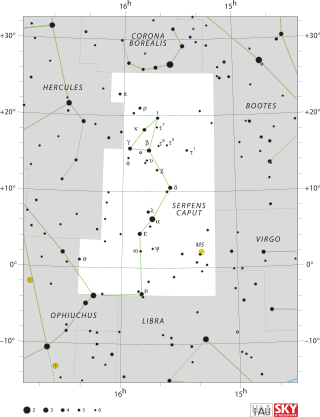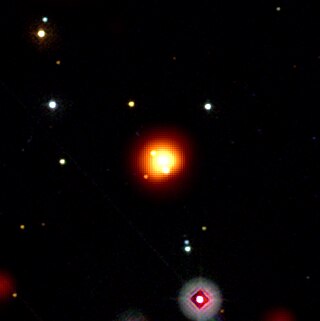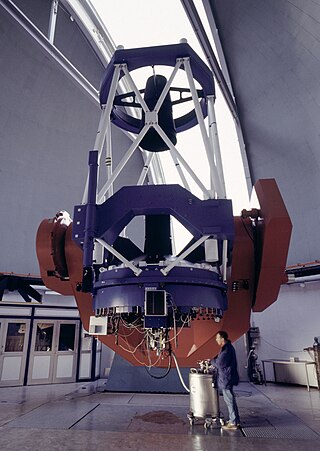
Fornax is a constellation in the southern celestial hemisphere, partly ringed by the celestial river Eridanus. Its name is Latin for furnace. It was named by French astronomer Nicolas Louis de Lacaille in 1756. Fornax is one of the 88 modern constellations.

Serpens is a constellation in the northern celestial hemisphere. One of the 48 constellations listed by the 2nd-century astronomer Ptolemy, it remains one of the 88 modern constellations designated by the International Astronomical Union. It is unique among the modern constellations in being split into two non-contiguous parts, Serpens Caput to the west and Serpens Cauda to the east. Between these two halves lies the constellation of Ophiuchus, the "Serpent-Bearer". In figurative representations, the body of the serpent is represented as passing behind Ophiuchus between Mu Serpentis in Serpens Caput and Nu Serpentis in Serpens Cauda.

In gamma-ray astronomy, gamma-ray bursts (GRBs) are immensely energetic explosions that have been observed in distant galaxies, described by NASA as "the most powerful class of explosions in the universe". They are the most energetic and luminous electromagnetic events since the Big Bang. Bursts can last from ten milliseconds to several hours. After an initial flash of gamma rays, a longer-lived "afterglow" is usually emitted at longer wavelengths.

Pictor is a constellation in the Southern Celestial Hemisphere, located between the star Canopus and the Large Magellanic Cloud. Its name is Latin for painter, and is an abbreviation of the older name Equuleus Pictoris. Normally represented as an easel, Pictor was named by Abbé Nicolas-Louis de Lacaille in the 18th century. The constellation's brightest star is Alpha Pictoris, a white main-sequence star around 97 light-years away from Earth. Pictor also hosts RR Pictoris, a cataclysmic variable star system that flared up as a nova, reaching apparent (visual) magnitude 1.2 in 1925 before fading into obscurity.
The eSTAR project was a multi-agent system that aimed to implement a heterogeneous network of robotic telescopes for automated observing, and ground-based follow-up to transient events. The project is a joint collaboration between the Astrophysics Group of the University of Exeter and the Astrophysics Research Institute at Liverpool John Moores University. The project was led by Alasdair Allan and Tim Naylor at the University of Exeter, and Iain Steele at Liverpool John Moores University. The eSTAR Project was affiliated with the RoboNet Consortium, and the global Heterogeneous Telescope Networks Consortium.

Gamma Leporis, Latinized from γ Leporis, is a star in the south central part of the constellation Lepus, southeast of Beta Leporis and southwest of Delta Leporis. With an apparent visual magnitude of 3.587, it is bright enough to be seen with the naked eye. Based upon an annual parallax shift of 112.02 mas as seen from Earth, its distance can be estimated as 29 light years from the Sun. It has a common proper motion companion, AK Leporis, which is a variable star of the BY Draconis type and has an average brightness of magnitude 6.28. The two are 95″ apart can be well seen in binoculars. Gamma Leporis is a member of the Ursa Major Moving Group.
Dale A. Frail is a Canadian astronomer working at the National Radio Astronomy Observatory (NRAO) in Socorro, New Mexico.

SN 1998bw was a rare broad-lined Type Ic gamma ray burst supernova detected on 26 April 1998 in the ESO 184-G82 spiral galaxy, which some astronomers believe may be an example of a collapsar (hypernova). The hypernova has been linked to GRB 980425, which was detected on 25 April 1998, the first time a gamma-ray burst has been linked to a supernova. The hypernova is approximately 140 million light years away, very close for a gamma ray burst source.

GRB 080319B was a gamma-ray burst (GRB) detected by the Swift satellite at 06:12 UTC on March 19, 2008. The burst set a new record for the farthest object that was observable with the naked eye: it had a peak visual apparent magnitude of 5.7 and remained visible to human eyes for approximately 30 seconds. The magnitude was brighter than 9.0 for approximately 60 seconds. If viewed from 1 AU away, it would have had a peak apparent magnitude of −67.57. It had an absolute magnitude of -38.6, beaten by GRB 220101A with -39.4 in 2023.

GRB 080913 was a gamma-ray burst (GRB) observed on September 13, 2008. The Swift Gamma-Ray Burst satellite made the detection, with follow-up and additional observations from ground-based observatories and instruments, including the Gamma-Ray Burst Optical/Near-Infrared Detector (GROND) and the Very Large Telescope. At 12.8 billion light-years and redshift of 6.7, the burst was the most distant GRB observed until GRB 090423 on April 23, 2009. This stellar explosion occurred around 825 million years after the Big Bang.

OGLE2-TR-L9 is a magnitude 15 star in the constellation Carina at a distance of approximately 5,142 light years.
The history of gamma-ray began with the serendipitous detection of a gamma-ray burst (GRB) on July 2, 1967, by the U.S. Vela satellites. After these satellites detected fifteen other GRBs, Ray Klebesadel of the Los Alamos National Laboratory published the first paper on the subject, Observations of Gamma-Ray Bursts of Cosmic Origin. As more and more research was done on these mysterious events, hundreds of models were developed in an attempt to explain their origins.

GRB 090423 was a gamma-ray burst (GRB) detected by the Swift Gamma-Ray Burst Mission on April 23, 2009, at 07:55:19 UTC whose afterglow was detected in the infrared and enabled astronomers to determine that its redshift is z = 8.2, making it one of the most distant objects detected at that time with a spectroscopic redshift.
GRB 011211 was a gamma-ray burst (GRB) detected on December 11, 2001. A gamma-ray burst is a highly luminous flash associated with an explosion in a distant galaxy and producing gamma rays, the most energetic form of electromagnetic radiation, and often followed by a longer-lived "afterglow" emitted at longer wavelengths.
GRB 070714B was a gamma-ray burst (GRB) that was detected on 14 July 2007 at 04:59 UTC. A gamma-ray burst is a highly luminous flash associated with an explosion in a distant galaxy and producing gamma rays, the most energetic form of electromagnetic radiation, and often followed by a longer-lived "afterglow" emitted at longer wavelengths.

The MPG/ESO telescope is a 2.2-metre f/8.0 (17.6-metre) ground-based telescope at the European Southern Observatory (ESO) in La Silla, Chile. It was built by Zeiss and has been operating since 1984. It was on indefinite loan to the European Southern Observatory from the Max Planck Institute for Astronomy (MPIA). In October 2013 it was returned to the MPIA. Telescope time is shared between MPIA and MPE observing programmes, while the operation and maintenance of the telescope are ESO's responsibility.

A kilonova is a transient astronomical event that occurs in a compact binary system when two neutron stars or a neutron star and a black hole merge. These mergers are thought to produce gamma-ray bursts and emit bright electromagnetic radiation, called "kilonovae", due to the radioactive decay of heavy r-process nuclei that are produced and ejected fairly isotropically during the merger process. The measured high sphericity of the kilonova AT2017gfo at early epochs was deduced from the blackbody nature of its spectrum.

GRB 160625B was a bright gamma-ray burst (GRB) detected by NASA's Fermi Gamma-ray Space Telescope on 25 June 2016 and, three minutes later, by the Large Area Telescope. This was followed by a bright prompt optical flash, during which variable linear polarization was measured. This was the first time that these observations were made when the GRB was still bright and active. The source of the GRB was a possible black hole, within the Delphinus constellation, about 9 billion light-years (light travel distance) away (a redshift of z = 1.406). It had a fluence of 5.7×10−4 erg cm−2, and energy of 5 × 1054 erg.

GRB 221009A also known as Swift J1913.1+1946 was an extraordinarily bright and long-lasting gamma-ray burst (GRB) jointly discovered by the Neil Gehrels Swift Observatory and the Fermi Gamma-ray Space Telescope on October 9, 2022. The gamma-ray burst was around seven minutes long, but was detectable for more than ten hours following initial detection, and for several hours was bright enough in visible frequencies to be observable by amateur astronomers. Despite being around two billion light-years away, it was powerful enough to affect Earth's atmosphere, having the strongest effect ever recorded by a gamma-ray burst on the planet. The peak luminosity of GRB 221009A was measured by Konus-Wind to be ~ 2.1 × 1047 J/s and by Fermi-GBM to be ~ 1.0 × 1047 J/s over the 1.024s interval. A burst as energetic and as close to Earth as 221009A is thought to be a once-in-10,000-year event. It was the brightest and most energetic gamma-ray burst ever recorded, being deemed the "BOAT", or brightest of all time.














